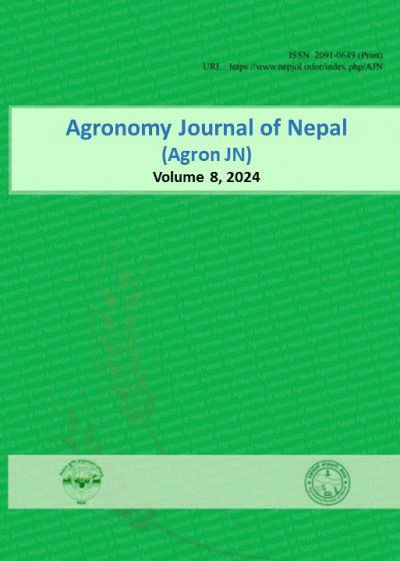Yield and Nitrogen Uptake of Wheat as Influenced by Nitrogen, Vermicompost and Biofertilizer Application at Rampur, Chitwan, Nepal
DOI:
https://doi.org/10.3126/ajn.v8i1.70854Keywords:
Chemical fertilizer, Vermicompost, Biofertilizer (Azotobacter chrococcom), Nitrogen uptakeAbstract
High cost, unavailability, and imbalance use of chemical fertilizers and environmental degradation are challenging sustainability of wheat production in Nepal. Integration of vermicompost, biofertilizer (Azotobacter chrococcom) and chemical fertilizer can improve the situation. A field experiment was conducted to assess the combined application of vermicompost, chemical fertilizer and biofertilizer on the growth, yield, and nitrogen uptake of wheat at Rampur Chitwan from November 2021 to April 2022. The experiment was laid out in a strip-split plot design with five N levels as horizontal factors (0, 25, 50, 75, and 100% of recommended dose), two vermicompost levels (0 and 5 t ha-1) as the vertical factor, and two biofertilizer levels (with and without application) as the sub-plot factor with three replications. Data on growth, yield attributes and yield of wheat, nitrogen uptake were collected, analyzed and presented. The research result revealed a significant influence of biofertilizer and nitrogen levels on grain yield of wheat. Full dose of nitrogen resulted a significantly higher grain yield (4441.71 kg ha-1) than other nitrogen levels (0, 25, 50, 75 % of recommended dose with grain yield 2792.11, 2982.20, 3771.17. 4231.63 kg ha-1 respectively). Biofertilizer application had significantly higher grain yield (3726.76 kg ha-1) compared with no biofertilizer application (3560 kg ha-1). There was significant interactions between biofertilizer application and nitrogen levels on number of grains per spike and sterility percent of wheat. The number of grain per spike was highest with 100% recommended N with biofertilizer application (47.52 grains/spike) followed by 75 % recommended N with biofertilizer application (46.53 grains/spike). The sterility % was lowest (6.47 %) with 100 % N with biofertilizer application followed by 75 % N with biofertilizer application (6.72 %). Total nitrogen uptake was significantly higher (119.04 kg ha-1) for full dose of nitrogen as compared with lower nitrogen levels (0, 25. 50, 75 % recommended N levels). Biofertilizer application also resulted in significantly higher nitrogen uptake (89.89 kg ha-1) as compared with no Biofertilizer application (79.89 kg ha-1). Integration of biofertilizer, with chemical fertilizer 75 - 100 % recommended N level could increase the growth, yield, and nitrogen uptake of wheat in Chitwan.
Downloads
Downloads
Published
How to Cite
Issue
Section
License
Copyright (c) 2024 Agronomy Society of Nepal (ASoN)

This work is licensed under a Creative Commons Attribution-NonCommercial 4.0 International License.
ASON permits for free use, distribution and reproduction in any medium if the original work is properly cited and not used for commercial purposes.




